According to Chinese culture, eating long noodles brings prosperity and longevity. This traditional belief has led to the creation of a specific type of noodle named “longevity noodles / 长寿面” These noodles are often served during special occasions such as birthday celebrations and Chinese New Year’s Eve.
The longevity noodles dish is a must-have dish during the reunion dinner. As family members from near and far journey home to be together again, they recount old stories and share new experiences in different places.
This recipe is perfect for the upcoming Chinese New Year. It’s a noodle dish that can also be enjoyed daily. Let me share the ingredients I use and provide step-by-step instructions on how to prepare them.
Note: This post may contain affiliate links. Please read my privacy policy for more info. I may receive commissions for purchases made through links in this post. As an Amazon Associate, I earn from qualifying purchases.
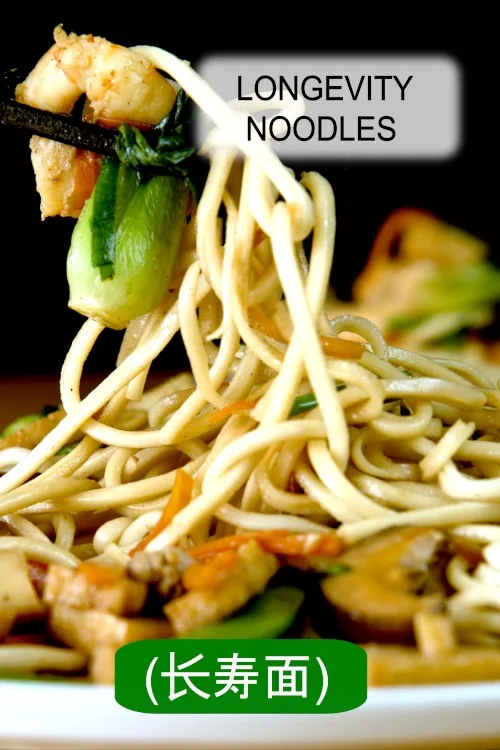
1. Ingredients for the longevity noodles
Longevity noodles (also called long life noodles) should be cooked cautiously so as not to break them. Once cooked, the noodles can be prepared with different ingredients.
There is no rule on what ingredients to use in a longevity noodle recipe, so I prefer to include ingredients associated with prosperity, happiness, and good luck. These ingredients are selected to symbolize longevity and good fortune, particularly suitable for Chinese New Year.
Some versions of the Longevity Noodles recipe are vegetarian, but I prefer adding meat and seafood to make it more wholesome. However, if you prefer a vegetarian option, you can use firm tofu as a source of protein.
a. The noodles
The best noodles to use are Longevity Noodles, specifically made for this dish and usually very long, perfect for the auspicious symbolism of the recipe. It is available at most Asian grocery stores, Another option would be yi mein noodles, also called e-fu noodles (伊面). Besides, any other type of long Chinese egg noodles will fit the criteria of making Longevity Noodles. Since the type of noodles you use may differ from what I use, please refer to the cooking instructions on the plastic wrap, especially the cooking time.
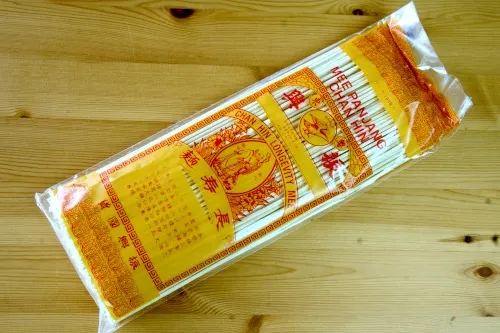
b. The Auspicious ingredients
- Prawns. In my recipe, I will use prawns because they symbolize laughter. In Cantonese, “prawns” is pronounced as “ha,” which sounds similar to the sound of laughter – “haha/哈哈.”
- Fish. In Cantonese, the word ‘Fish’ is pronounced as ‘Yu,’ which sounds similar to the word for abundance and excess, “余”. This makes it an auspicious ingredient for making Longevity Noodles. However, fish meat tends to be too soft for stir-frying, making it unsuitable to be fried with the noodle. To solve this problem, I use ready-made fish cake, a type of deep-fried fish meat patty, and cut it into slices to be included in the dish. If you can’t get fish cake, you can use fish balls, which are more commonly available.
- Chinese chives. The next ingredient is Chinese chives 韭菜” (jiǔcài). The first character has the same pronunciation as the word “long/ 长” in Cantonese and Mandarin, which makes it meaningful for making Longevity Noodles. If you can’t find it, you can use green onions as a substitute.
- The vegetables. When selecting vegetables for a dish, I consider their color, crunchiness, and texture. For instance, I would choose carrots for their bright color and some leafy green vegetables for both their color and contrasting texture to the noodles. I opted for baby bok choy and sweet peas in this recipe, but cabbage and choy sum would also work well. Moreover, the Chinese word for vegetables, 菜, is a homonym for money/fortune, 财, which adds more auspicious meaning to the noodle dish.
- Shitake Mushrooms. Dried shiitake mushrooms add extra flavor to the noodles. I soak the mushrooms until they become soft and then cut them into thick slices to prepare them. In Cantonese, this mushroom is known as 冬菇, which means 东成西就, which translates to “success in all undertakings” in English.”
- Eggs. There is one more common ingredient that you can add to the list of ingredients for longevity noodles, which is the egg. I omitted eggs in my recipe because I already have many ingredients.
c. The seasonings
Since this is a Cantonese-style noodle dish, the seasoning will consist of light soy sauce, dark soy sauce, oyster sauce, Chinese wine, sesame oil, ground white pepper, sugar, and salt. These are the common ingredients used in most Cantonese (and other Chinese) cuisine. I prefer to pre-mix them in a small bowl before cooking to avoid missing out on any of these items during the cooking process. Besides these seasonings, I use chicken broth instead of water while stir-frying and constitute some cornstarch slurry to thicken the sauce. You can add some dried pepper flakes if you like them spicy.
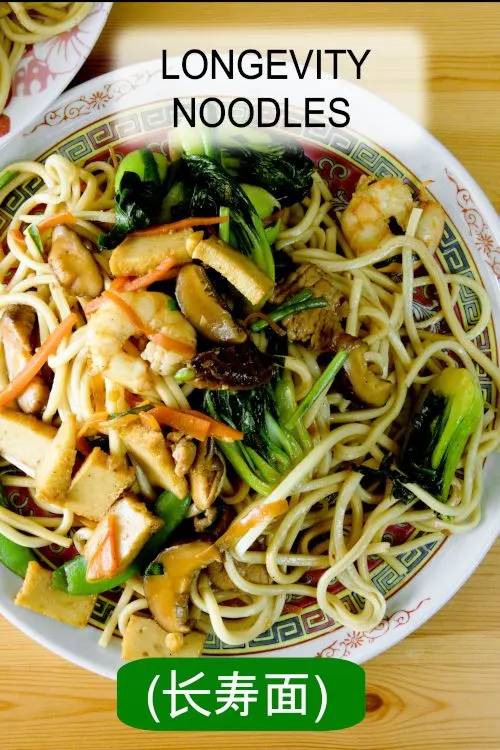
2. Preparing the Longevity Noodles
Here are the steps to prepare the longevity noodles:
a. Blanch the noodles according to the instructions on the packaging
- Bring water to a boil in a stock pot or large wok.
- Place the longevity noodles in the boiling water to blanch for the duration as stated on the packaging.
- Once the noodles start to turn soft, loosen them with chopsticks and cook until al dente.
- Remove the noodles from the boiling water and transfer them to a pot of cold water to stop further cooking. This step can prevent the noodles from turning soggy.
- Lastly, remove the noodles from the cold water with a large strainer and set aside for later use.
Note: Please follow the instructions on the packaging of the noodles you purchase as they may differ from what I use.
b. Get ready for other ingredients required for the recipe.
- Prepare the chopped garlic.
- Cut the fish cakes into slices, about half a centimeter thick.
- Clean the prawns, devein them, and remove their shells.
- Cut the pork tenderloin into thin slices. Marinate it with salt and light soy sauce.
- Clean the baby bok choy. Cut them in half lengthwise.
- Cut the carrot into small strips
- Remove the fibrous strings of the sweet peas.
- Soak the dried shiitake mushrooms and cut them into thick slices.
- Cut the Chinese chives into one-inch sections.
- Mix all the ingredients B in the recipe below to make the sauce for the noodles.
c. Stir-fry the ingredients for the Longevity noodles
- Heat the vegetable oil in the wok or a large skillet, then stir-fry the prawns until they change color. Remove and set them aside.
- Use the remaining oil to stir-fry the pork and add the chopped garlic midway through cooking.
- Add the fish cakes and mushrooms when the pork is cooked. You can add splashes of water if it’s too dry.
- Include the bok choy and carrot. Pour half a cup of chicken broth to cook the veggies, and add the prepared sauce.
- Add the sweet peas and Chinese chives when the chicken broth has reduced.
- Return the cooked noodles to the wok and mix thoroughly with all the ingredients and seasonings. Be careful not to break the noodles.
- Do a taste test and adjust by adding salt or other seasonings if required. Dish out and serve.
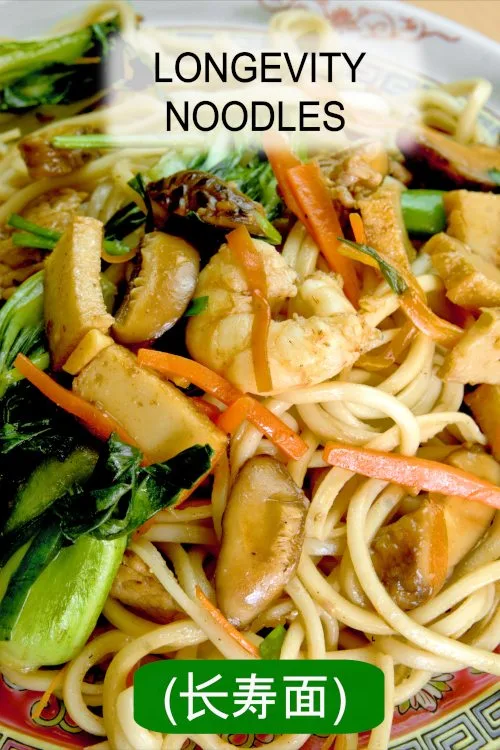
3. Other auspicious recipes for the Lunar New Year
During the Chinese New Year, we always prepare special dishes that symbolize prosperity, happiness, and abundance. If you want to try making these dishes at home, we have an article listing 10 auspicious foods that bring fortune and prosperity. Please refer to our article “Chinese New Year Recipes – 10 Auspicious Foods That Bring You Fortune and Prosperity” for recipes.
Longevity noodles recipe (长寿面)
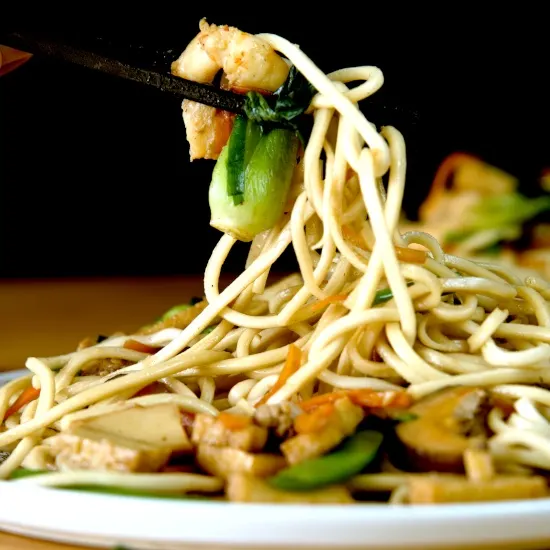
Longevity noodles recipe (长寿面) for Chinese New Year that symbolizes long life, made with meat and mushrooms.
Ingredients
Ingredients A
- 300g longevity noodles
- 2 pieces of fish cakes (sliced)
- 6 medium size prawns
- 100g sliced pork (marinate with 1/4 tsp salt and one tsp of light soy sauce)
- 5 Baby bok choy
- 10 sweet peas
- Half a medium size carrot (shredded)
- 5 dried Shitake mushrooms (soaked and cut into pieces)
- 40 g Chinese chives (cut into one-inch sections)
- 1 tbsp chopped garlic
- 4 tbsp of vegetable oil
- Salt to taste
- Half a cup of chicken broth
Ingredients B
- 1.5 tablespoons oyster sauce
- 1 tablespoon soy sauce
- 1 tablespoon dark soy sauce
- 1 teaspoon sugar
- 1/4 tsp ground white pepper
- 1 tbsp Shaoxing wine
- 1 teaspoon sesame oil
Instructions
Prepare the noodles
- Bring water to a boil in a stock pot or large wok.
- Place the longevity noodles in the boiling water to blanch for the duration as stated on the packaging.
- Once the noodles start to turn soft, remove the noodles from the boiling water and transfer them to a pot of cold water to stop further cooking. Lastly, remove the noodles from the cold water and set aside for later use.
Prepare the ingredients
- Prepare the chopped garlic.
- Cut the fish cakes into slices, about half a centimeter thick.
- Clean the prawns, devein them, and remove their shells.
- Cut the pork tenderloin into thin slices. Mariabte with salt and light soy sauce.
- Clean the baby bok choy. Cut them in half lengthwise.
- Cut the carrot into small strips
- Remove the fibrous strings of the sweet peas.
- Soak the dried shiitake mushrooms and cut them into thick slices.
- Cut the Chinese chives into one-inch sections.
- Mix all the ingredients B in the recipe below to make the sauce for the noodles.
Stir-fry the ingredients for the Longevity noodles
- Heat the vegetable oil in the wok or a large skillet, then to stir-fry the prawns until they change color. Remove.
- Stir-fry the pork and add the chopped garlic midway through cooking.
- Add the fish cakes and mushrooms when the pork is cooked. You can add splashes of water if it's too dry.
- Include the bok choy and carrot. Pour half a cup of chicken broth to cook the veggies, and add the prepared sauce (Ingredients B)
- Add the sweet peas and Chinese chives when the chicken broth has reduced.
- Return the cooked noodles to the wok and mix thoroughly.
- Do a taste test and adjust by adding salt or other seasonings if required. Dish out and serve.
Recommended Products
As an Amazon Associate and member of other affiliate programs, I earn from qualifying purchases.
Nutrition Information:
Yield:
3Serving Size:
1Amount Per Serving: Calories: 1048Total Fat: 34gSaturated Fat: 5gTrans Fat: 1gUnsaturated Fat: 26gCholesterol: 96mgSodium: 1533mgCarbohydrates: 130gFiber: 35gSugar: 37gProtein: 59g
This data was provided and calculated by Nutritionix on 12/18/2023

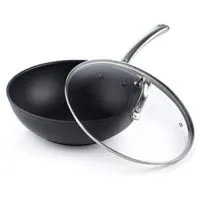
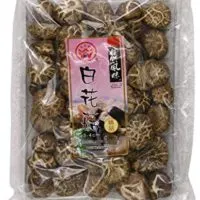
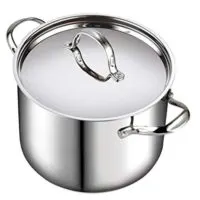
KP Kwan
Tuesday 19th of December 2023
Hi, this is KP Kwan. Thank you for reading my recipe. Please feel free to ask any questions or leave comments. I’ll respond as soon as possible.